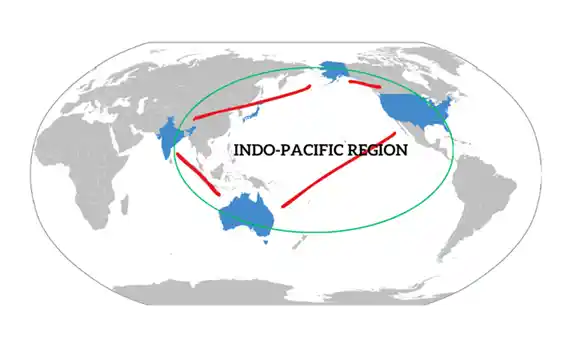The Quad, formally known as the Quadrilateral Security Dialogue, is a strategic forum that brings together the United States, India, Japan, and Australia. It was initiated in 2007 by Japanese Prime Minister Shinzo Abe, with the support of leaders from the other three countries. The dialogue is maintained through talks between member countries and is focused on issues related to security in the Indo-Pacific region.
Origins:
- The Quad began as a loose partnership after the 2004 Indian Ocean tsunami, when the four countries collaborated to provide humanitarian and disaster assistance.
Evolution:
- Initially formalized in 2007, the Quad fell dormant for nearly a decade, particularly amid concerns that it would antagonize China.
- It was revived in 2017, reflecting changing attitudes towards China’s growing regional influence and the need for a concerted response to various security challenges.
Objectives:
- The Quad aims to deepen economic, diplomatic, and military ties among the four nations¹.
- While not explicitly stated often, the partnerships are intended to serve as a counterbalance to China’s assertive actions in the region.
Activities:
- The Quad members have held joint military exercises, such as Exercise Malabar, and conduct regular dialogues to discuss strategic issues.
Not an ‘Asian NATO’:
- Despite China’s criticism of the Quad as an attempt to form an ‘Asian NATO’, the group does not have a mutual-defense pact. Instead, it focuses on collaboration and maintaining a “free, open, inclusive, healthy, anchored by democratic values, and unconstrained by coercion” Indo-Pacific region.

The Quad represents a significant element of the contemporary geopolitical landscape in the Indo-Pacific, emphasizing the importance of a rules-based maritime order and a shared commitment to stability and prosperity in the region.
How does China view the Quad?
China’s perspective on the Quadrilateral Security Dialogue (Quad) has evolved over time, shifting from dismissive to more serious and concerned. Initially, Chinese officials like Foreign Minister Wang Yi referred to the Quad as “sea foam” in the Pacific, suggesting it would soon dissipate without impact. However, as the Quad has become more institutionalized and active, China has started to view it as a potential challenge to its interests.
Chinese analysts have expressed concerns that the Quad could undermine China’s economic influence in the region by providing alternative infrastructure investment financing or creating new supply chains that bypass China. They also perceive the Quad as an effort by the US and its allies to contain and encircle China, potentially pressuring China along its eastern and southern flanks.
Moreover, China sees the Quad’s objectives, which emphasize a “free and open Indo-Pacific,” as implicitly challenging its authoritarian governance and regional ambitions. Beijing understands that the Quad, while not a formal alliance, shares deep concerns about China’s role in the Indo-Pacific and has the potential to impede China’s rise.
In summary, China views the Quad as part of a broader political and ideological challenge, especially in its relations with more open, liberal, and democratic societies. The Quad’s increasing significance and the possibility of it becoming an effective global and regional actor have led to a more contested relationship between the Quad and China.
How does India view the Quad?
India views the Quad as a strategic and diplomatic platform rather than a military alliance. The Indian perspective emphasizes the Quad’s role in fostering peace and stability in the Indo-Pacific region without directly targeting any country, including China. India’s influence on the Quad agenda is evident, with a focus on non-traditional security issues and public goods.
India’s approach to the Quad is shaped by several factors:
- Non-Alignment: Historically, India has been hesitant to engage in alliance politics, preferring strategic autonomy and non-alignment.
- Border with China: India shares a disputed land border with China, making it cautious about being perceived as part of an anti-China coalition.
- Regional Concerns: India is aware that any military-focused grouping could raise concerns among Southeast Asian nations, who have a direct stake in the region’s stability.
India’s engagement with the Quad reflects its broader foreign policy of multi-alignment, where it seeks to maintain friendly relations with multiple global powers, even those with conflicting interests. The Quad serves India’s interests by providing a platform for diplomatic engagement and cooperation on shared challenges without entangling India in a formal military alliance.
Overall, India’s role within the Quad is pivotal, as it seeks to shape the grouping into an institutionalized framework that addresses a wide array of issues in the Indo-Pacific, beyond just the military realities posed by China’s rise.